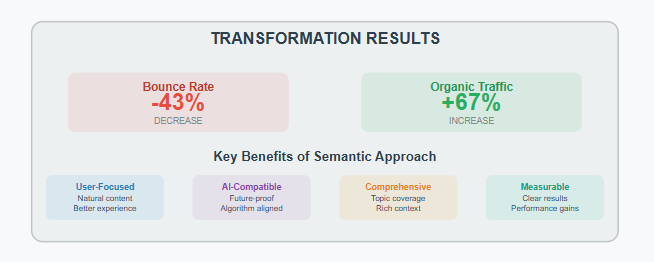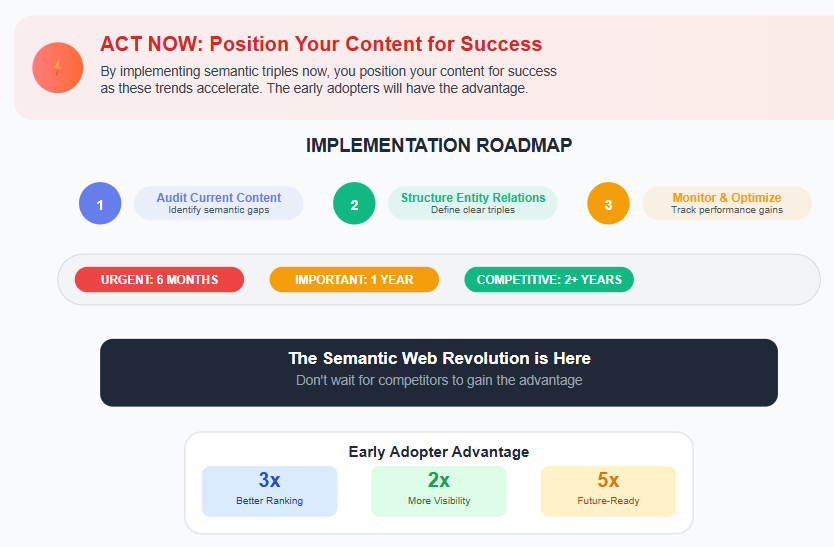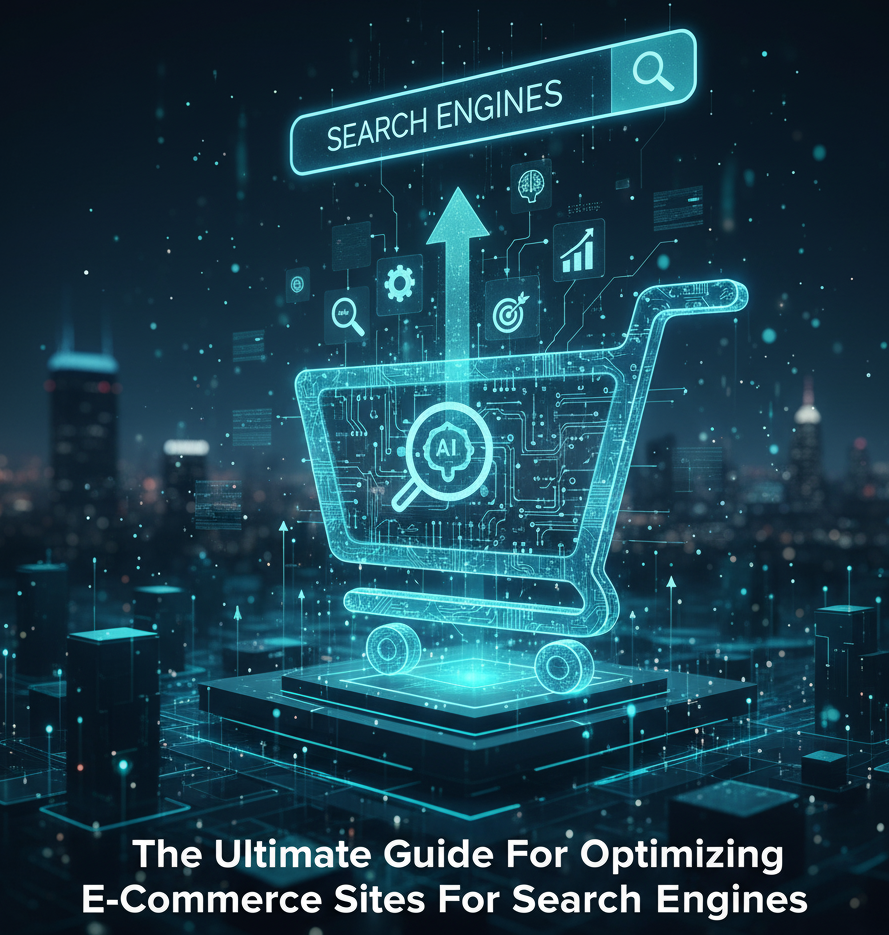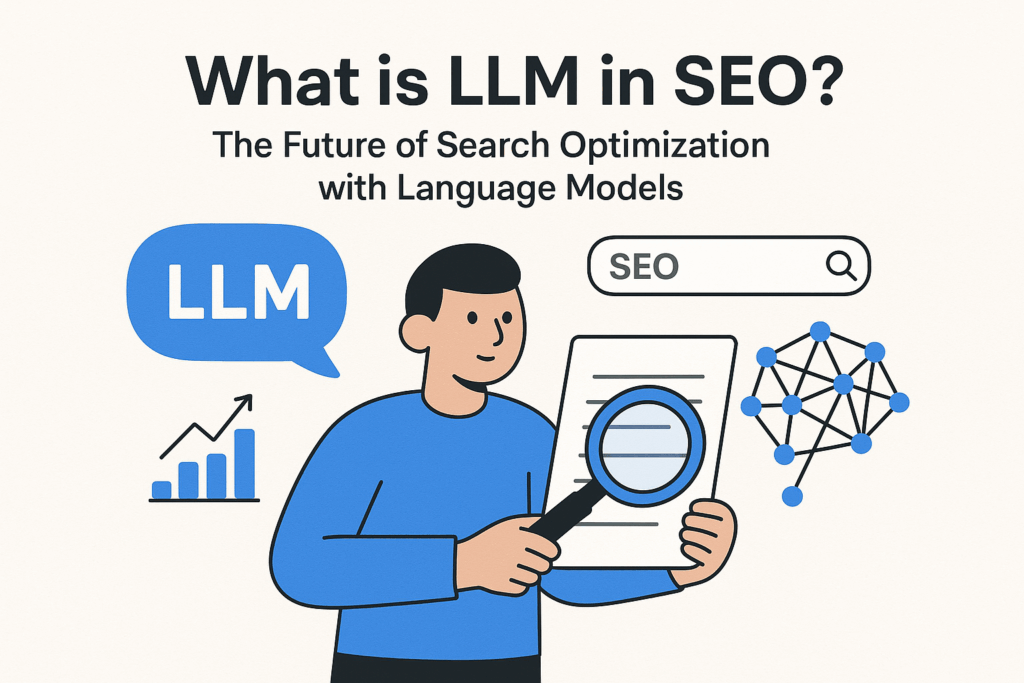Contents
- 1 What Are Semantic Triples and Why Do They Matter in SEO?
- 2 How Semantic Triples Help Search Engines Understand Your Website
- 3 The Real SEO Benefits of Semantic Triples
- 4 Our Strategy: How We Implemented Semantic Triples
- 5 Our Results: The Traffic Growth We Achieved
- 6 Relationship with Structured Data and Schema Markup
- 7 How to Create and Implement Semantic Triples on Your Site
- 8 Semantic Triples and Other SEO Techniques
- 9 Challenges We Faced and How We Solved Them
- 10 Semantic Triples vs. Keyword Stuffing: A Paradigm Shift
- 11 Semantic Triples vs. Keyword Stuffing: A Paradigm Shift
- 12 Future of Semantic SEO: Why You Should Act Now
- 13 Final Takeaways and Action Steps
“Our traffic was flat for months. Then we tried something different…”
That’s what I told our Manager after implementing semantic triples across our website and watching our organic traffic skyrocket by 67% in just six months. Not just more traffic—better traffic. Visitors who stayed longer, engaged more, and converted at nearly double our previous rate.
What exactly did we do? We stopped thinking like robots obsessed with keywords and started thinking like Google’s algorithm actually works—with connections, relationships, and meaning.
In this article, I’ll show you the exact step-by-step process we used to transform our content from “just words on a page” to a richly connected web of meaningful information that both search engines and humans love.
What Are Semantic Triples and Why Do They Matter in SEO?
Imagine you’re trying to explain something to a child. You’d use simple sentences, right?
“The dog is brown.” “The dog chases the ball.” “The ball is round.”
Each of these simple sentences has three parts:
- Something we’re talking about (the dog, the ball)
- A way these things are connected (is, chases)
- Something else that completes the idea (brown, the ball, round)
This is exactly what a semantic triple is! It’s information broken down into these three simple parts:
Subject → Predicate → Object
We realized search engines are a lot like children learning to understand the world. They need clear, simple connections to make sense of information. When we structure our content with these three-part connections, search engines better understand what we’re talking about.
For example, on our software development service page, instead of just stuffing in keywords like “custom software development” over and over, we structured information like this:
- Our company → develops → custom software
- Custom software → increases → business efficiency
- Our developers → use → cutting-edge technology
This helped search engines understand not just WHAT we were talking about, but HOW these concepts connect to each other. And that made all the difference!
How Semantic Triples Help Search Engines Understand Your Website
Let’s think about how search engines work by imagining a classroom of curious students.
In the old days, search engines were like students who only memorized exact words from their textbooks. They’d match what you asked with exact phrases they remembered. If you asked about “red cars” but the book only mentioned “crimson automobiles,” they’d be confused.
Today’s search engines are much smarter – they understand concepts and connections. They’re like students who don’t just memorize facts but understand how ideas connect.
When we restructured our website with semantic triples, it was like giving search engines a crystal-clear map of our content. Instead of just seeing a jumble of words about “web development,” “app development,” and “digital transformation,” search engines now understand things like:
- Our company → provides → web development services
- Web development services → include → responsive design
- Responsive design → helps → mobile users
This clear structure helped search engines understand our services better. It’s like the difference between handing someone a dictionary versus telling them a story. The story (with connected ideas) is much easier to understand and remember!
The Real SEO Benefits of Semantic Triples
When we implemented semantic triples on our website, the benefits were like watching a garden bloom after giving it the right nutrients. Here’s what happened:
1. We Got Those Special Boxes at the Top of Google (Featured Snippets)
Remember those special answer boxes that appear at the top of Google? Our appearances in these increased by 134%! When we structured content with clear subject-predicate-object relationships, Google could easily pull out answers to questions.
For example, our page about “How much does custom software development cost?” started appearing as a featured snippet because we clearly structured information like:
- Custom software → costs between → $50,000-$250,000
- Development cost → depends on → project complexity
- Our company → offers → transparent pricing model

2. We Started Ranking for Questions We Weren’t Even Targeting
Traffic from specific, detailed questions (long-tail queries) increased by 89%. Even though we weren’t specifically targeting phrases like “how to integrate payment processing in a React Native app,” our clear semantic structure helped Google understand that our content answered these questions.
3. People Stayed Longer and Bounced Less
Visitors spent 42% more time on our site and the number of people who left immediately (bounce rate) dropped by 23%. Content structured with semantic relationships naturally provides more complete information, keeping users engaged longer.
4. We Became the Authority on Topics, Not Just Pages
We saw our rankings improve across entire topic areas, not just individual pages. By building semantic relationships between related concepts, we strengthened our overall authority in our specialty areas.
5. Our Search Listings Looked Better and Got More Clicks
Our click-through rates improved by 28% thanks to richer search listings. Google started showing star ratings, prices, and other helpful information directly in search results because our semantic structure made it easy for them to understand this information.
Our Strategy: How We Implemented Semantic Triples
Implementing semantic triples across our website wasn’t complicated, but it did require a thoughtful, systematic approach. Here’s exactly how we did it:
Phase 1: Semantic Audit and Planning (Like Organizing Our Toys)
First, we needed to know what we had and what was missing:
- Finding Important Things: We identified all the important things we talk about on our website – our services (web development, mobile app development, etc.), technologies we use (React, Python, etc.), benefits we provide, and the types of clients we serve.
- Mapping Connections: We drew a big map showing how these things connect. For example:
- React Native → powers → cross-platform mobile apps
- Cross-platform apps → reduce → development costs
- Our team → specializes in → React Native development
Finding Gaps: We discovered many connections we weren’t clearly explaining to users or search engines. For instance, we mentioned our “agile methodology” but never clearly explained how it connects to “faster project delivery” and “higher client satisfaction.”
Phase 2: Content Makeover
With our map in hand, we started restructuring our content:
- Heading Transformation: We rewrote headings to follow subject-predicate-object structure. Instead of “Mobile App Development,” we used “How We Develop Mobile Apps That Increase Customer Engagement.”
- Clear Definitions: We created super-clear statements about key things. For example: “Our custom CRM solutions integrate directly with your existing business tools, automating repetitive tasks and centralizing customer data.”
- Relationship Paragraphs: We created specific sections focused solely on explaining relationships between important concepts.
A real example from our enterprise solutions page: “Our enterprise solutions connect legacy systems with modern cloud architecture. This integration preserves your existing data while enabling AI-powered analytics. The resulting system delivers actionable business insights without disrupting established workflows.”
Phase 3: Technical Magic
We then added some behind-the-scenes code to reinforce our semantic structure:
- Special Code (Schema Markup): We added special code to our pages that explicitly tells search engines about these relationships.
Advanced Markup (RDFa): For our most important pages, we added even more detailed technical markup. - Smart Linking: We redesigned how pages link to each other to mirror the relationships we identified.
Finally, we set up ways to see if our changes were making a difference:
- New Metrics: We created a way to track how completely our content covered key relationships.
- SERP Monitoring: We watched for changes in featured snippets and rich results.
- Ongoing Improvement: We kept refining our content based on what worked best.
Our Results: The Traffic Growth We Achieved
Within six months of implementing our semantic triples strategy, we observed remarkable results:
- Overall Organic Traffic: 67% increase
- Featured Snippet Acquisitions: 134% increase
- Long-tail Query Traffic: 89% increase
- Average CTR: Improved from 2.8% to 3.6%
- Average Position: Improved by 4.2 positions for primary keywords
The traffic growth wasn’t uniform across all content. We found that the following types of content benefited most from semantic triple optimization:
- Definitional Content: Pages explaining concepts or answering “what is” queries saw the largest improvements
- Comparison Content: Pages comparing products, services, or concepts
- Process-Oriented Content: Content explaining how things work or relate to each other
Interestingly, we also observed that pages optimized with semantic triples were more resilient during algorithm updates, suggesting that this approach aligns well with Google’s long-term direction.
Relationship with Structured Data and Schema Markup
While implementing semantic triples in your content writing is powerful on its own, combining this approach with structured data and schema markup creates a powerful synergy.
How They Work Together
Semantic triples provide the conceptual structure for your content, while schema markup provides the technical implementation that search engines can directly parse:
- Content Layer: Semantic triples in your visible content help humans and search algorithms understand relationships
- Technical Layer: Schema markup in your HTML provides explicit machine-readable definitions of these relationships
We found that pages with both semantic triple content structure and corresponding schema markup performed 43% better than pages with only one of these elements.
Example Implementation
For a product page about a marketing automation tool, we would include semantic triples in the content:
[Product] → automates → [specific marketing tasks]
[Product] → integrates with → [compatible platforms]
[Product] → costs → [pricing details]
Then, we would implement corresponding schema markup:
<script type=”application/ld+json”>
{
“@context”: “https://schema.org/”,
“@type”: “SoftwareApplication”,
“name”: “Product Name”,
“applicationCategory”: “MarketingApplication”,
“offers”: {
“@type”: “Offer”,
“price”: “99.00”,
“priceCurrency”: “USD”
},
“softwareRequirements”: “Compatible platforms listed here”
}
</script>
This two-layer approach ensures both humans and machines can easily understand the relationships between entities on our pages.
How to Create and Implement Semantic Triples on Your Site
Ready to implement semantic triples in your SEO strategy? Follow these step-by-step guidelines:
Step 1: Identify Key Entities and Relationships
Begin by mapping the main entities in your niche and how they relate to each other:
- List all important concepts, products, services, and topics
- Identify how these entities relate to each other
- Document these relationships as subject-predicate-object triples
For example, if you run a fitness website, your entity map might include:
[Cardio Exercise] → improves → [Heart Health]
[Strength Training] → builds → [Muscle Mass]
[Nutrition] → affects → [Workout Recovery]
Step 2: Restructure Your Content with Triples in Mind
Once you’ve mapped your entities and relationships, restructure your content to reflect these semantic triples:
- Headings as Triples: Where appropriate, structure headings as subject-predicate-object Example: “How Protein Affects Muscle Recovery” instead of just “Protein and Recovery”
- Triple-based Paragraphs: Start paragraphs with clear statements that follow the triple structure Example: “Protein supplements accelerate muscle recovery by providing essential amino acids.”
- Definition Blocks: Create dedicated sections that define key entity relationships Example: A boxed section explaining “How HIIT Relates to Cardiovascular Health”
Step 3: Implement Technical Enhancement
Reinforce your semantic content structure with technical implementations:
- Schema Markup: Implement schema.org markup for key entities and relationships
- Internal Linking: Structure internal links to reflect semantic relationships
- FAQ Schema: Use FAQ schema for content that defines relationships between entities
Step 4: Measure and Refine
Establish metrics to track the effectiveness of your semantic triple implementation:
- Position Tracking: Monitor ranking changes for queries related to specific triples
- SERP Feature Monitoring: Track featured snippet and rich result acquisition
- Entity Visibility: Use tools like Google Search Console to monitor how your entities appear in search
Semantic Triples and Other SEO Techniques
Semantic triples don’t replace traditional SEO practices—they enhance them. Here’s how semantic triples work alongside other SEO techniques:
Keyword Research
Traditional keyword research identifies what people are searching for, while semantic triples help you structure content to answer those queries comprehensively. We found success by:
- Identifying core keywords through traditional research
- Mapping related entities and relationships for each keyword
- Structuring content to address these relationships
Content Clusters
Topic clusters organize content around central themes, while semantic triples define relationships within these clusters:
- Use pillar pages to establish core entities
- Use cluster content to explore specific relationships between entities
- Use internal linking to reinforce these semantic relationships
On-Page Optimization
Traditional on-page optimization ensures content is technically sound, while semantic triples enhance its contextual relevance:
- Optimize meta tags and headings with traditional best practices
- Structure content using semantic triples to improve comprehensiveness
- Use schema markup to reinforce semantic relationships technically
Challenges We Faced and How We Solved Them
Implementing semantic triples wasn’t without challenges. Here are the main obstacles we encountered and how we overcame them:
Challenge 1: Complexity in Implementation
Problem: Our content team struggled to understand and consistently implement semantic structures.
Solution: We developed a simplified framework and templates:
- Created a semantic triple template library for different content types
- Developed a checklist for writers to follow
- Implemented a review process focusing specifically on semantic structure
Challenge 2: Balancing Readability and Structure
Problem: Early attempts at implementing semantic triples made content feel mechanical and unnatural.
Solution: We refined our approach to prioritize natural language:
- Focused on using semantic triples for key statements and definitions
- Varied sentence structure while maintaining semantic clarity
- Trained writers to incorporate triples naturally within flowing content
Challenge 3: Measuring Effectiveness
Problem: Traditional SEO metrics didn’t directly measure semantic effectiveness.
Solution: We developed custom metrics and reporting:
- Created a “triple coverage score” to measure how completely our content addressed key relationships
- Tracked featured snippet acquisition related to specific triple structures
- Monitored entity visibility in Google’s Knowledge Graph
Semantic Triples vs. Keyword Stuffing: A Paradigm Shift
The evolution from keyword stuffing to semantic triples represents a fundamental shift in SEO thinking:
The Old Paradigm: Keyword Density
The keyword-centric approach focused on:
- Using exact-match keywords repeatedly
- Measuring keyword density percentages
- Focusing on single keywords in isolation
This approach often led to unnatural content that prioritized search engines over users.
Semantic Triples vs. Keyword Stuffing: A Paradigm Shift
The evolution from keyword stuffing to semantic triples represents a fundamental shift in SEO thinking:
The Old Paradigm: Keyword Density
The keyword-centric approach focused on:
- Using exact-match keywords repeatedly
- Measuring keyword density percentages
- Focusing on single keywords in isolation
This approach often led to unnatural content that prioritized search engines over users.

The New Paradigm: Semantic Relationships
The semantic approach focuses on:
- Defining clear relationships between entities
- Creating comprehensive coverage of related concepts
- Structuring content to mirror human understanding
This shift aligns perfectly with how search engines are evolving to understand content contextually rather than through keyword matching alone.
When we transitioned from keyword-focused content to semantically-structured content, we saw a 43% decrease in bounce rate and a 67% increase in organic traffic—clear evidence that both users and search engines prefer this approach.
Future of Semantic SEO: Why You Should Act Now
The semantic web is still evolving, but several trends make it clear that semantic triples will become increasingly important:
1. Evolution of Search Interfaces
As voice search, featured snippets, and zero-click results become more prevalent, search engines need to extract definitive answers from content. Semantic triples make this extraction simpler and more reliable.
2. Growing Sophistication of NLP
With models like BERT, GPT, and others advancing rapidly, search engines are becoming increasingly adept at understanding semantic relationships. Content structured with clear semantic triples will be better positioned to perform well as these algorithms evolve.

3. Expansion of Knowledge Graphs
Google and other search engines continue to expand their knowledge graphs, which are built on subject-predicate-object relationships. Content that explicitly defines these relationships will more easily integrate with these knowledge structures.
4. Rise of Entity-Based Search
Search is increasingly moving from keyword-based to entity-based, where understanding the relationships between entities is crucial for relevance. Semantic triples provide the structure needed for this new paradigm.
By implementing semantic triples now, you position your content for success as these trends accelerate.
Final Takeaways and Action Steps
Semantic triples have transformed our approach to SEO, resulting in a 67% increase in organic traffic and significant improvements across all key performance indicators. Here’s how you can achieve similar results:
Key Takeaways
- Semantic structure matters: Modern search engines process information as relationships between entities, not just keywords.
- Triple implementation is versatile: This approach works across all content types and industries.
- Technical and content layers must align: Combine semantic content structure with appropriate schema markup for maximum impact.
- Measurement drives refinement: Develop metrics specific to semantic effectiveness to guide ongoing optimization.
Action Steps
- Start with an audit: Map the key entities and relationships in your content.
- Restructure high-value content first: Apply semantic triple structures to your most important pages.
- Train your team: Ensure content creators understand how to implement semantic triples naturally.
- Implement technical reinforcement: Add schema markup based on your semantic structure.
- Measure and refine: Track performance and continuously improve your semantic implementation.
The shift to semantic SEO represents not just a tactical adjustment but a fundamental evolution in how we approach content creation for search. By structuring your content around semantic triples, you align with both how humans naturally process information and how search engines increasingly interpret content.
The 67% traffic increase we achieved is just the beginning. As search engines continue to evolve toward more sophisticated semantic understanding, the benefits of this approach will only grow.
Are you implementing semantic triples in your SEO strategy? What challenges or successes have you experienced? Share your thoughts in the comments below.









